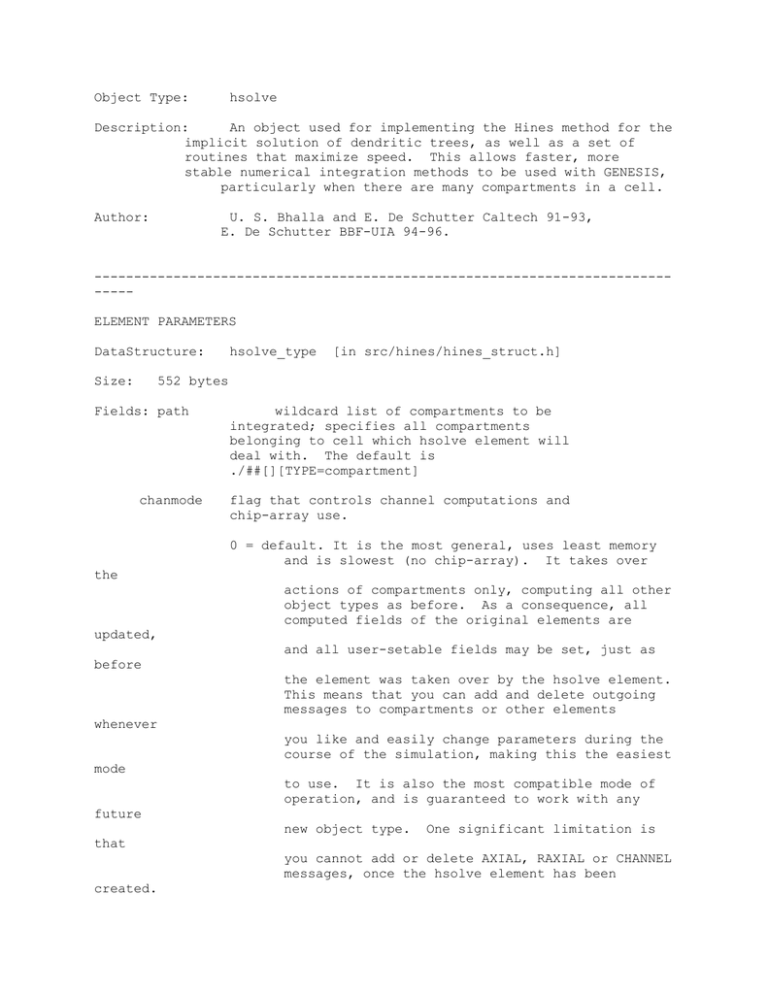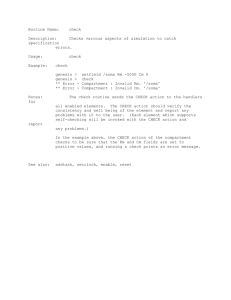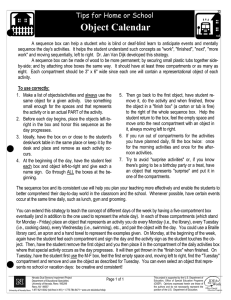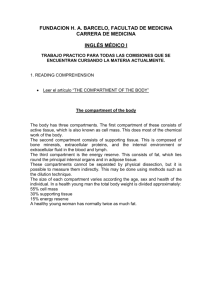HSOLVE.DOC
advertisement

Object Type:
hsolve
Description:
An object used for implementing the Hines method for the
implicit solution of dendritic trees, as well as a set of
routines that maximize speed. This allows faster, more
stable numerical integration methods to be used with GENESIS,
particularly when there are many compartments in a cell.
Author:
U. S. Bhalla and E. De Schutter Caltech 91-93,
E. De Schutter BBF-UIA 94-96.
----------------------------------------------------------------------------ELEMENT PARAMETERS
DataStructure:
Size:
hsolve_type
[in src/hines/hines_struct.h]
552 bytes
Fields: path
chanmode
wildcard list of compartments to be
integrated; specifies all compartments
belonging to cell which hsolve element will
deal with. The default is
./##[][TYPE=compartment]
flag that controls channel computations and
chip-array use.
0 = default. It is the most general, uses least memory
and is slowest (no chip-array). It takes over
the
actions of compartments only, computing all other
object types as before. As a consequence, all
computed fields of the original elements are
updated,
and all user-setable fields may be set, just as
before
the element was taken over by the hsolve element.
This means that you can add and delete outgoing
messages to compartments or other elements
whenever
you like and easily change parameters during the
course of the simulation, making this the easiest
mode
to use. It is also the most compatible mode of
operation, and is guaranteed to work with any
future
new object type.
One significant limitation is
that
you cannot add or delete AXIAL, RAXIAL or CHANNEL
messages, once the hsolve element has been
created.
1 = like chanmode 0, but optimizes calculations for
tabchannel equations. This will be faster than
chanmode 0 for models containing tabchannels and
tab2Dchannels.
2 = assumes integer exponents (maximum = 6) for
tabchannel and tab2Dchannel gate variables.
Chanmodes
2-4 are the fastest because of the large 'chiparray'.
Vm fields of all compartments are updated, but
other
fields will not be updated after the cell is
taken
over by hsolve.
Incoming messages from the
disabled
elements are supported, providing that they are
established before the hsolve element is set up.
Outgoing messages from the disabled elements are
not
supported.
3 = as chanmode 2, but Vm fields of compartments
are
not automatically updated. All disabled elements
(including compartments) that had outgoing
messages
to non-hsolved objects during the SETUP call are,
however, updated at a rate determined by
outclock.
Thus SAVE and PLOT messages will work properly.
4 = as chanmode 3, but more variables (e.g. Gk,
Ik,
Ek, Im and leak) are stored by hsolve so that
they can
be accessed by SAVE or PLOT messages (see
findsolvefield documentation for more details).
comptmode
flag that selects option for compartment computations
0 = uses least memory, and is slightly slower. However
the amount of time spent in this part is usually
less
than 10% of the total, so this should not matter.
1 = the default, uses a lot of memory and is twice as
fast for the actual Hines matrix calculation.
This
may be only a 5% difference.
required for chanmodes 2-4.
calcmode
comptmode 1 is
flag affecting operations for chanmodes 2-4.
0 = no interpolation will be performed in lookup
tables. This mode is for backward compatibility
with
older versions of hsolve (prior to GENESIS 2.1)
which
did not use interpolation.
1 = default mode with linear interpolation of
values
in lookup tables.
storemode
flag to allow the output of total currents and
conductances. For each type of voltage gated
channel
in the model, the total currents or conductances
are
the sum of the corresponding Ik or Gk fields for
all
compartments where the channel is present. This
assumes that these channels have the same name in
each
compartment. These are stored in an array called
itotal. When the hsolve element is set up, a
message
will be output giving a list of channel names and
corresponding itotal indices, if the 'silent'
command
has previously been given with a negative
argument.
0 = no sums are stored.
1 = total currents are stored.
2 = total conductances are stored.
no_elminfo = 0/1; flag that controls whether the HPUT and HSET
actions will work. Is relevant only for chanmodes
2-4. Default is zero (HPUT and HSET work).
Saves memory if non-zero value is used (HPUT, HSET
do not work; HRESTORE and HSAVE do).
outclock
number [0-99] of the clock used for all element
updates if chanmode = 3 or 4, will affect SAVE
and
PLOT messages.
The element update routines are
not
very efficient, so setting them to a slower clock
will
speed up things.
Note however that any object
that is
not computed by the hines solver and that depends
on a
message from a hsolve-computed object will be
affected.
The other fields displayed with the showobject command are NOT
to be set by the user.
----------------------------------------------------------------------------SIMULATION PARAMETERS
Function:
HinesSolver
Classes:
hsolver
Actions:
RESET does the standard reset functions, but also for
chanmodes 2-4, it will update all parameters in
the chip-array (equivalent to a HRESTORE call) and
recompute rate factor tables if clocks were changed.
DELETE
PROCESS
[in src/hines/hsolve.c]
standard actions
standard actions
SETUP setup all internal tables. Must be called before the
hsolve element is used. User accessible fields
(path, chanmode, etc.) should have been set. Model
changes after the SETUP call may have no effect on
the computations.
DUPLICATE
does an efficient duplication of an hsolve
element.
Use this in a network simulation for identical
copies of a neuron. Only the tables containing
changing parameters (Vm, etc.) will be duplicated.
Syntax: call hsolve1 DUPLICATE hsolve2
HPUT
updates chip-array. Fields from a single element are
put into the chip-array (chanmodes 2 or 3). Do this
call after a setfield command on the element.
Syntax: call hsolve HPUT element_path
HGET
updates hsolve-computed element. Computed values are
put from the chip-array into a single element
(chanmodes 2-4). Do this call before a getfield
on
the element.
Syntax: call hsolve HGET
element_path
HRESTORE the complete chip-array is updated. Fields from all
hsolve-computed elements are put into chip-array
(chanmodes 2-4). Do this call after a restore
command or after multiple setfield commands.
Syntax: call hsolve HRESTORE
HSAVE all hsolve-computed elements are updated.
Computed
values are put from the chip array into all elements
(chanmodes 2-4). Do this call before a save
command or before multiple getfield commands.
Syntax: call hsolve HSAVE
Messages:
None.
Example:
// Do all the preparatory grunge work
.
.
// create the cell as an hsolve element
readcell test.p /test -hsolve
// set the chanmode, comptmode and calcmode (if other than
defaults)
setfield /test chanmode 2
// set up the arrays and tables for the solver
call /test/solve SETUP
// use the Crank-Nicholson method for the hsolve element
setmethod 11
// It is essential to call reset (or reschedule) after setting
// up an hsolver, so that the process list gets updated.
reset
----------------------------------------------------------------------------Notes:
The hsolve element completely takes over the calculations for compartment
elements and certain other elements specified as part of the cell. Each
hsolve element should only solve one cell. The timestep for the
integration
is determined by the clock assigned to the hsolve element, and the clocks
for these elements which are taken over are ignored.
When using the Hines solver with a neuron, it is best to think of the
entire
neuron as a single object since the individual compartments within the
cell
are no longer responsible for their own computations. This loss of
object
orientedness is mitigated to some degree by the ability of the solver to
transparently interact with elements utilizing other integration schemes.
There are 2 basic modes for hsolve operation: without chip-array
(chanmode 0
or 1), or with chip-array (chanmodes 2-4). Without chip-array is the
most
compatible mode, but is the slowest. With the chip-array, hsolve is much
faster because the original elements are no longer used, instead all
simulation parameters are stored in a huge array (this improves memory
access
times). Unfortunately you can no longer expect that it will update the
fields
in computed objects (like Vm in a compartment or Ca in Ca_concen) so that
graphic or file output might not work. Vice versa, if you change a field
(like inject in compartment) it might not affect the simulation.
However,
there are methods available to get values in and out of the chip-array,
which
involve special settings and/or the use of the HPUT, HGET, HSAVE and
HRESTORE
actions listed above. This is ilustrated in another example below. The
documentation for findsolvefield describes another method, introduced in
GENESIS 2.1, that also allows access to these values.
The example above illustrates the process of setting up the hsolve
element.
First, one should create the cell as an hsolve element at the root of the
cell
element tree. This may be done in one step by using the "-hsolve" option
with
readcell. If readcell is not used, then the hsolved cell should be
created
with statements like
create hsolve /test
create compartment /test/soma
create tabchannel /test/soma/Na_channel
...
Next, set any fields of the hsolve which are needed to specify nondefault
values of chanmode, comptmode, calcmode, storemode, etc. Then, one needs
to
call the SETUP action in order to tell the hsolve element to create all
the
solution arrays and tables. Finally, chose either method 10 (backwards
Euler)
or 11 (Crank-Nicholson) as the method to be used. All elements which lie
outside this tree will continue to be treated by the previous explicit
method
(typically exponential Euler). The Scripts/examples/hines directory
contains
an example script which demonstrates both chanmodes 0 and 2.
Although it is not presently necessary to create the hsolve element as
the
root of the element tree, future versions of hsolve may require this.
The
older method of creating the hsolve is to create the cell as a neutral
element, create the hsolve element as a child element, and then set the
hsolve
path field to indicate which elements will be taken over. Typically, a
wildcard path is used to refer to all compartment elements in the
simulation.
This includes all hsolvable sublelements of these compartments. For
example,
// readcell will place the compartments below the neutral '/test'
readcell test.p /test
// create the hines solver element below the cell '/test'
create hsolve /test/solve
// Specify the path for the solver
set /test/solve path /test/##[][TYPE=compartment]
RESTRICTIONS
It is important to be aware of some of the restrictions imposed by the
use
of hsolve:
Only the objects compartment, tabchannel, tab2Dchannel, tabcurrent,
spikegen,
Ca_concen, nernst, Mg_block, ghk, taupump, mmpump, difshell, fixbuffer,
difbuffer, dif2buffer, synchan, and the oldconn library channels
channelC2 and
channelC3 are handled by hsolve. If your simulation uses these listed
objects, hsolve will increase speed significantly. In principle,
unlisted
objects will also be computed correctly (though slower, as they are
integrated
by the 'older' explicit methods). Note that symcompartment objects are
NOT
handled by hsolve. This means that there is little advantage in using
hsolve
for dendritic trees composed of symmetric compartments.
An important restriction introduced in GENESIS version 2.1 is that, for
chanmodes 2-4, the element tree of your cell (or other element tree to be
taken over by hsolve) must not contain any non-hsolvable elements other
than
neutral elements. For existing simulations which violate this
restriction, it
will be easiest to switch to chanmode 0 or 1.
It is not guaranteed that messages from unlisted objects to listed
objects
will work, though solve should alert you about any such
incompatibilities.
Most incoming messages will work if you use chanmodes 2-4. Messages from
listed to unlisted objects will only work for certain chanmode settings.
hsolve does not keep track of changes made to the model after the hsolve
SETUP
command (particularly the following commands: create, copy, delete,
addmsg,
deletemsg). In chanmode 0 or 1 this only affects the listed objects and
messages between them, in chanmodes 2-4 this affects the listed objects
and
ALL messages going in or out from them. The hsolver should be used in
these
modes only for finished models (you can use it for parameter searches);
do not
use it if you are still constructing and testing a model.
hsolve may miscalculate if you change clocks used by tabchannels,
tab2Dchannels, synchans, or channelC2/C3 objects without doing a reset
(only
in chanmodes 2-4).
The Hines solver utilizes a considerable amount of memory. Memory use
increases as the result of comptmode + chanmode - no_elminfo flags. In
particular, going from chanmode 0 or 1 to chanmode 2, 3, or 4 causes a
big
jump in memory usage. Approximately 100 bytes are required per
compartment if
the speed-optimized version of the hsolve element is used. Most of this
storage is for tables describing the sequence of calculations. These
tables
can, however, be shared between cells which are identical in topology and
differ only in parameter values.
FURTHER EXAMPLES
* Copying cells with the hsolve element
When a cell using the hsolve element is copied, the pointers in the
duplicated hsolve element are unchanged. In other words, they refer back
to
the original cell. One could simply change the path to refer to the
current
cell and call SETUP again, but that would unnecessarily duplicate a lot
of
tables. The efficient option would be to use the original tables where
they
are identical, and construct new ones where they refer to the current
cell.
This is done using the DUPLICATE command. Continuing with the previous
example,
// Copy the original cell to /test2
copy /test /test2
// Duplicate the hsolver. The DUPLICATE action
// takes the new path as an argument
call /test2/solve DUPLICATE /test2/##[][TYPE=compartment]
There are several commands, including createmap and cellsheet, which copy
cells. The DUPLICATE command should be issued for the hsolvers on each
copy.
* Deleting hsolve elements
When an hsolve element is set up it removes the relevant channels and
compartments from the list of elements to be processed, by setting a bit
(0x100) on the flag field of those elements. These elements are reenabled
and the bit set back to 0 when the hsolve element is deleted.
WARNING: in the present implementation, the hsolve element does not check
whether it has had duplicates made using the DUPLICATE command. This
makes it
possible to delete the tables for all of the copies by deleting any one
of
them, resulting in segmentation violations and similar amusements. In
other
words, do not delete hsolves on duplicated cells.
* Accessing data fields in chanmodes 2-4.
A script similar to this example might be used for running a long
simulation
as a background job, using no graphics. The HPUT and HSAVE actions are
used
in chanmode 2 or 3 to allow the simulation results and the final state of
the simulation to be saved to disk. A disk_out element is used to output
the
Vm of a soma compartment in a compressed binary format. However, it is
equally possible to output Vm from every compartment, or from an array of
cells. Later, a script using a disk_in element can display the results
using
messages from the disk_in to an xgraph or xview. The save command is
used
here to save field values of all elements except nernst elements and the
hsolve element. This will allow the simulation to be resumed from its
final
state by using the restore command.
For more details, see Scripts/examples/XODUS/fileview and the
documentation
for disk_out, disk_in, save, and restore.
/* load scripts and global variables */
include defaults
include other_stuff
pushe /library
make_my_stuff
pope
/* make the model */
readcell my_cell {my_cellpath} -hsolve
/* set the clocks */
setclock 0 1e-5
/* integration */
setclock 1 1e-4
/* output */
/* create the output or graphics elements */
/* note that if you want to output Vm only, but from multiple
** compartments, you should use chanmode == 2; if you want to
** output other fields or Vm from only one compartment,
** use chanmode == 3 */
create disk_out /output/disk
useclock /output/disk 1
addmsg {my_cellpath}/soma /output/disk Vm
addmsg ...
/* create any other elements */
....
/* setup the hines solver */
setfield {my_cellpath} \
comptmode
1 \
chanmode
3 \
outclock
1
call {my_cellpath} SETUP
setmethod 11
// Crank-Nicholson integration method
/* initialize output */
setfield /output/plot_out filename {filename} initialize 1
setfield /output/plot_out filename {filename} append 1 leave_open 1
reset
step 0.10 -t
/* do a current injection */
setfield {my_cellpath}/soma inject 1.0e-9
/* update chip array */
call {my_cellpath} HPUT {my_cellpath}/soma
step 2.00 -t
/* in Amps */
/* save the integration values to disk */
call {my_cellpath} HSAVE
save {my_cellpath}/##[][TYPE!=nernst][TYPE!=hsolve] {savename}
quit
-------------------------------------------------------------------------DETAILED DESCRIPTION
The Hines library provides elements and functions for the efficient
implicit
solution of the systems of differential equations arising in singleneuron
models. The sparse matrix arising from the the branched structure of
neurons
is ordered by the method described by Michael Hines, which permits it to
be
solved in order N operations using Gaussian elimination without pivoting.
The nonlinear equations resulting from the Hodgkin-Huxley description of
ion
channels are treated as conditionally linear, and also solved in an
efficient, second-order manner. Compatibility with other integration
schemes is maintained so that mixed integration schemes are feasible.
The element sets up a data structure whereby the only change needed for
other identical cells is to reassign pointers to the compartment and
channel
elements. This avoids having to reallocate and rederive the solving
scheme. Solutions are done using gaussian forward and backward
elimination
without pivoting. The numbering and evaluation sequence ensures that no
new
off-diagonal terms are formed which might mess up the sparse matrix
representation. The sparse matrix is represented by a single 'values'
array
indexed using the ri and cip arrays. The actual solution system is
stored
as a linear sequence of operations on the 'values' array, in an attempt
to
speed things up a bit.
The implicit method leads to numerically stable solutions for all time
steps. Numerical accuracy, however, imposes limits on the integration
time
step which must be empirically evaluated for each simulation. Typical
values are 100 microsecond time steps for purely passive membranes and 20
microsecond time steps for membranes with active channels. This confers
a
considerable speed up in detailed neuronal simulations where the presence
of
electrotonically small compartments (such as dendritic spines) leads to
systems of equations which are numerically very stiff. In order to obtain
similar accuracy using explicit integration methods, time steps in the
nanosecond range may be required.
In addition to the substantial speed advantage gained from the use of an
implicit solution, the coding of the Hines solver element has been done
with
a view to computational efficiency. This results in a speed up of around
50%
compared to the same model with the same time step, using the
conventional
explicit Euler integration scheme.
Code changes needed for the Hines library
This section is probably of interest only to individuals who have
developed
their own code libraries and who are deeply entangled in GENESIS coding
issues. For most users the changes are transparent, once the .simrc and
schedule.g file have been updated to reflect the addition of a new
library.
The incorporation of a completely new integration scheme to the simulator
can
be expected to have numerous repercussions. Fortunately, the changes
needed for
the Hines library turned out to be relatively painless. No changes were
needed
for the code of any of the existing elements. There is a slight
rearrangement
of the order of fields in the various channel objects, and a new globally
#define'd type called CHAN_TYPE has been created so that all these
channel
objects have the following common fields at identical memory offsets: Ik,
Gk
and Ek (See src/sim/struct_defs.h). All channels whose structures obey
this
convention can be used in cells utilizing the hsolve element. A very
small
number of channel objects (such as channelC) do not share these fields
and
therefore cannot be part of cell models which use the hines solver.
A new flag (0x100) has been employed for the Hines solver, which causes
the
removal of compartment and tabchannel elements from the action list (the
list
of elements whose action functions are to be called according to the
clocks).
This flag is similar to the disable option except that it leaves the
children
of these elements intact.
In the interests of speed (which is, after all, what the Hines method is
all
about) I have 'unrolled' the sparse matrix solution into a single giant
function array. This is done at setup time, so the actual solution does
not
involve any conditionals and minimises array lookups. This is moderately
expensive in terms of memory. The size of the function array allocated is
S = FA * sizeof (int) ;
FA = 10 + 1.5 * M^2 / N
where S is the size of the array, FA is the number of functions
allocated, M
is the number of non-zero coefficients in the solution matrix and N is
the
number of compartments. M depends strongly on the branching pattern of
the
cell. FA is an approximation to, and is greater than F, which is the
actual
number of locations needed in the function table. For example, in a
mitral
cell model, which has limited branching:
N = 286 ; M = 856 ; FA = 3853 ; S = 15412 ; F = 3710
In a granule cell model with numerous dendritic spines:
N = 944 ; M = 2830 ; FA = 12736 ; S = 50944 ; F = 12264
A reasonable approximation is that each compartment requires about 54
bytes in
the function table, which is not too bad.
References: Hines, M. (1984) Efficient computation of branched nerve
equations. Int. J. Bio-Med. Comp. 15: 69-76
Mascagni, M.V. (1989) Methods in Neuronal Modeling Ed: Koch
and Segev. Chapter 13. 439-484
See also:
setmethod, findsolvefield


